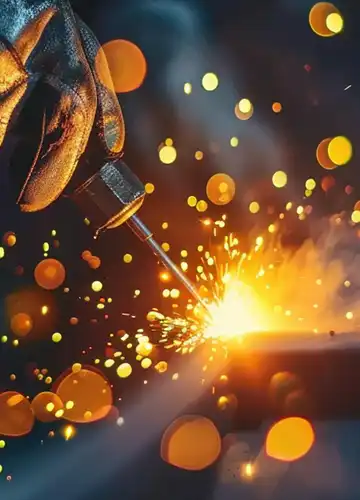- +971 43807099
- +971 563244963
- brisunco@emirates.net.ae
Edit Content

- Meet Us
Shed No. 10,
Fresh Express Warehouse, Road B1, DIP 1,
Dubai, UAE.

Shed No. 10,
Fresh Express Warehouse, Road B1, DIP 1,
Dubai, UAE.


New
New
Welding is the cornerstone of modern manufacturing and metal fabrication, serving as the essential process that joins materials, typically metals, by causing coalescence. For industries requiring robust and precise structures, understanding the different welding techniques is crucial. Among the most common and versatile are Metal Inert Gas (MIG) welding, Tungsten Inert Gas (TIG) welding, and Shielded Metal Arc Welding (SMAW), commonly known as Stick welding.
Each technique offers distinct advantages and is suited for different applications within the broad spectrum of welding and fabrication. Let’s read more about them.
At a Glance
At its heart, welding involves creating a strong, metallurgical bond between two or more pieces of material. This is typically achieved by applying heat to melt the material edges, often with the addition of a filler material, which then cools to form a single, solid joint. A protective atmosphere, usually an inert gas or a flux, is employed to shield the molten weld pool from atmospheric contamination, which could otherwise weaken the weld.
The choice of technique depends on the material, thickness, desired aesthetic, and application.
1. MIG Welding (Gas Metal Arc Welding – GMAW)
MIG welding is widely regarded as one of the easiest welding processes to learn and master, making it highly popular in various industrial settings, including the general-purpose requirements of many welding and fabrication shops.
How it Works: MIG welding uses a continuously fed wire electrode that is consumed as filler material. An inert shielding gas (usually argon or a mixture of argon and carbon dioxide) flows around the wire, protecting the weld pool from atmospheric contaminants. The arc is struck between the wire and the workpiece, melting both the wire and the base metal.
Key Advantages: This technique offers high speed, making it productive for long welds and repetitive tasks. It produces clean welds with minimal spatter and requires less post-weld cleanup compared to Stick welding. It is highly versatile, capable of welding a wide range of metals, including steel, stainless steel, and aluminum, across various thicknesses. Its ease of use makes it suitable for automated processes.
Best Suited For: Automotive repairs, manufacturing, general fabrication, structural steel work, and projects requiring high productivity. It is excellent for welding thinner materials and for automated or robotic welding applications.
2. TIG Welding (Gas Tungsten Arc Welding – GTAW)
TIG welding is celebrated for its precision, control, and ability to produce exceptionally clean and high-quality welds. It is often the preferred choice when aesthetics and precise control are paramount in welding and fabrication.
How it Works: TIG welding uses a non-consumable tungsten electrode to create the arc. A separate filler rod is fed manually into the weld pool by the welder. An inert shielding gas (typically pure argon) protects the tungsten electrode and the weld area. The welder has independent control over heat input and filler material, allowing for very fine adjustments.
Key Advantages: This method produces extremely clean, precise, and high-quality welds with superior aesthetic appeal and minimal spatter. It offers excellent control over the weld pool, making it ideal for thin materials and critical applications. It can weld nearly all metals, including exotic alloys, very thin materials, and dissimilar metals. It can be performed with or without filler material.
Best Suited For: Aerospace, medical devices, highly aesthetic components, pipe welding, precision fabrication, and welding exotic metals or very thin gauges where quality and appearance are critical.
3. Stick Welding (Shielded Metal Arc Welding – SMAW)
Stick welding is one of the oldest and most widely used welding processes, particularly valued for its robustness and versatility in challenging environments within welding and fabrication.
How it Works: Stick welding uses a consumable electrode covered with a flux coating. The electrode rod itself serves as both the filler material and the source of the shielding gas. When the arc is struck, the flux coating disintegrates, producing a protective gas cloud and a slag layer that shields the molten weld pool from the atmosphere.
Key Advantages: It is highly portable due to minimal equipment requirements, making it excellent for outdoor and field work. It is very tolerant of dirty or rusty materials and less affected by wind compared to gas shielded processes. It is cost-effective for many applications and highly versatile, capable of welding a wide range of ferrous metals, including steel and cast iron, in various positions.
Best Suited For: Heavy structural steel erection, pipeline construction, general repairs, maintenance work, and outdoor applications where conditions might be less than ideal.
Welding is the process of permanently joining two or more metal pieces using heat, pressure, or both. Different techniques such as MIG, TIG, or stick welding create joints with varying strengths.

The selection of the appropriate welding technique is crucial for the success of any fabrication project. Factors such as the type and thickness of the metal, the required weld quality and appearance, the project budget, and the working environment all play a role. For instance, if you require high-speed production on thicker materials, MIG welding might be ideal. For intricate, visually critical welds on specialized alloys, TIG welding is often unparalleled. For robust outdoor structural work, Stick welding offers unmatched resilience.
MIG, TIG, and Stick welding are foundational processes in the world of metal fabrication. Each offers a unique combination of advantages suited to different applications, materials, and quality requirements. Understanding their distinct characteristics empowers better decision-making in projects involving metal joining. These techniques, when applied by skilled professionals, ensure the strength, durability, and precision vital for all forms of welding and fabrication.
For your next project requiring expert welding and fabrication, contact Brightsun Industries today!
Q1: Which welding technique is best for beginners?
MIG welding is generally considered the easiest welding technique for beginners to learn due to its continuous wire feed and less demanding arc control compared to TIG or Stick welding.
Q2: Can TIG welding be used on very thin metals?
Yes, TIG welding is exceptionally well suited for very thin metals because it offers superior control over heat input, preventing burn-through and distortion that might occur with other welding methods.
Q3: What are the main safety precautions to take when performing any welding and fabrication work?
Essential safety precautions include wearing appropriate personal protective equipment (PPE) such as welding helmets, flame-resistant clothing, and gloves, ensuring proper ventilation to extract fumes, implementing fire prevention measures, and following electrical safety protocols.
Q4: Is it possible to weld aluminum with Stick welding?
While technically possible with specialized electrodes, Stick welding is generally not recommended for aluminum due to its poor arc stability, porosity issues, and difficulty in achieving a clean weld on this material. MIG or TIG welding is far more suitable for aluminum.
Q5: What is the primary role of shielding gas in MIG and TIG welding?
The primary role of shielding gas in MIG and TIG welding is to protect the molten weld pool, the electrode, and the hot filler metal from atmospheric contamination (oxygen, nitrogen, water vapor), which can cause porosity, brittleness, and weaken the weld.
At a Glance
Related Blogs
Shed No. 10, Fresh Express Warehouse,
Road B1, Dubai Investments Park 1,
Dubai, UAE.
+971 43807099
+971 563244963
+971 503226480